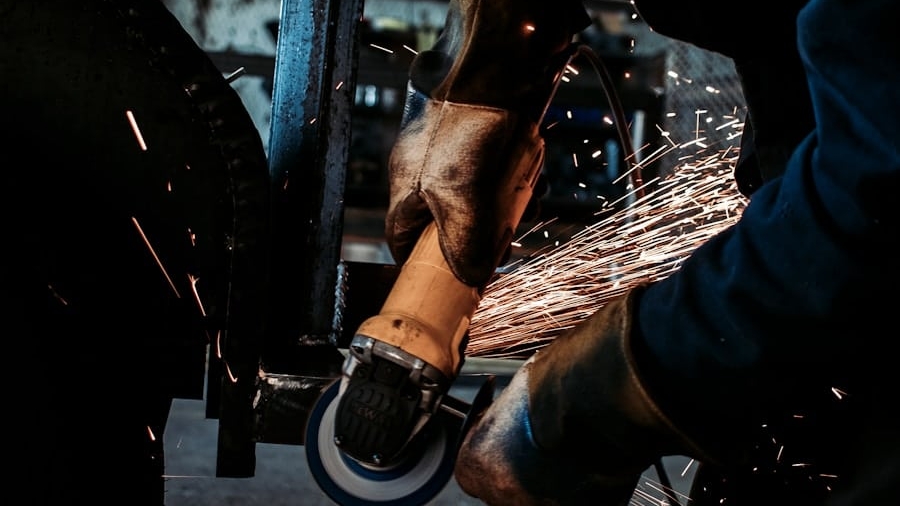In recent years, the integration of technology into various sectors has transformed traditional practices, and the industrial sector is no exception. Smart bracelets, equipped with advanced sensors and connectivity features, have emerged as a pivotal tool in enhancing workplace safety. These wearable devices are designed to monitor various physiological parameters and environmental conditions, providing real-time data that can significantly reduce the risk of workplace injuries.
As industries strive to create safer work environments, smart bracelets offer a proactive approach to injury prevention, enabling employers to address potential hazards before they escalate into serious incidents. The adoption of smart bracelets in industrial settings is not merely a trend; it represents a fundamental shift in how safety protocols are implemented. By leveraging the Internet of Things (IoT) and data analytics, these devices can track workers’ movements, monitor vital signs, and even detect hazardous conditions.
This technological advancement allows for a more dynamic response to safety concerns, moving away from reactive measures to a more preventive strategy.
Key Takeaways
- Smart bracelets are becoming increasingly popular in industrial settings for preventing workplace injuries.
- Preventing workplace injuries is crucial in industrial settings to ensure the safety and well-being of workers.
- Smart bracelets work by monitoring and analyzing workers’ movements and providing real-time feedback to prevent injuries.
- The benefits of using smart bracelets in industrial settings include reducing the risk of injuries, improving productivity, and lowering healthcare costs.
- Case studies have shown successful implementation of smart bracelets in industrial settings, leading to a safer work environment and reduced injury rates.
The Importance of Preventing Workplace Injuries in Industrial Settings
Workplace injuries in industrial settings can have devastating consequences, not only for the affected employees but also for the organizations themselves. The financial implications of workplace accidents are staggering; they can lead to increased insurance premiums, legal liabilities, and lost productivity. According to the Occupational Safety and Health Administration (OSHA), businesses spend approximately $1 billion per week on direct workers’ compensation costs alone.
This figure underscores the urgent need for effective injury prevention strategies that can mitigate risks and protect workers. Moreover, the human cost of workplace injuries is immeasurable. Injuries can lead to long-term health issues, emotional distress, and even fatalities.
The psychological impact on coworkers and the overall workplace morale can also be significant. A safe work environment fosters employee satisfaction and retention, which are crucial for maintaining a productive workforce. Therefore, investing in preventive measures, such as smart bracelets, is not just a regulatory obligation but a moral imperative for organizations committed to their employees’ well-being.
How Smart Bracelets Work to Prevent Injuries
Smart bracelets function through a combination of sensors, data analytics, and connectivity features that work together to monitor various aspects of a worker’s environment and health. These devices are typically equipped with accelerometers, gyroscopes, heart rate monitors, and temperature sensors that collect data on physical activity levels, vital signs, and environmental conditions. For instance, an accelerometer can detect sudden movements or falls, while a heart rate monitor can alert supervisors if an employee’s heart rate exceeds safe thresholds during strenuous activities.
The data collected by smart bracelets is transmitted in real-time to a centralized system where it can be analyzed for patterns and anomalies. This capability allows safety managers to identify potential risks before they result in injuries. For example, if a worker’s bracelet indicates excessive fatigue or stress levels, supervisors can intervene by providing rest breaks or adjusting workloads accordingly.
Additionally, some smart bracelets are designed to send alerts when workers enter hazardous areas or when environmental conditions become unsafe, such as high levels of noise or toxic gases.
Benefits of Using Smart Bracelets in Industrial Settings
The implementation of smart bracelets in industrial environments offers numerous benefits that extend beyond mere injury prevention. One of the most significant advantages is the enhancement of real-time communication between workers and management. With features such as emergency alerts and location tracking, supervisors can quickly respond to incidents or emergencies, ensuring that help is dispatched promptly.
Furthermore, smart bracelets contribute to a culture of safety by promoting awareness among employees about their health and working conditions. When workers are equipped with devices that monitor their well-being, they become more conscious of their physical state and the potential hazards around them.
This heightened awareness can lead to safer behaviors on the job site, as employees are more likely to adhere to safety protocols when they understand the implications of their actions. Additionally, organizations can leverage the data collected from these devices to conduct training sessions tailored to specific risks identified through analytics, further enhancing overall safety practices.
Case Studies of Successful Implementation of Smart Bracelets
Several organizations have successfully integrated smart bracelets into their safety protocols, demonstrating their effectiveness in preventing workplace injuries. One notable example is a large manufacturing company that implemented smart bracelets across its production floor. The company faced challenges with high rates of musculoskeletal injuries due to repetitive tasks and heavy lifting.
By equipping employees with smart bracelets that monitored their movements and provided real-time feedback on posture and lifting techniques, the organization was able to reduce injury rates by over 30% within the first year. Another compelling case study comes from a construction firm that adopted smart bracelets to enhance safety on job sites. The firm utilized bracelets equipped with GPS tracking and environmental sensors to monitor workers’ exposure to hazardous conditions such as extreme temperatures and high noise levels.
When the sensors detected unsafe conditions, alerts were sent directly to workers’ devices, prompting them to take necessary precautions or relocate to safer areas. As a result of this proactive approach, the company reported a significant decrease in heat-related illnesses and accidents associated with noise exposure.
Challenges and Limitations of Smart Bracelets in Preventing Workplace Injuries
Despite their numerous advantages, the implementation of smart bracelets in industrial settings is not without challenges. One significant concern is data privacy and security. As these devices collect sensitive information about workers’ health and movements, organizations must ensure that this data is protected from unauthorized access or breaches.
Failure to safeguard this information could lead to legal repercussions and damage employee trust. Additionally, there may be resistance from employees regarding the use of smart bracelets due to concerns about surveillance or discomfort with wearing technology during work hours. It is essential for organizations to foster an open dialogue with employees about the benefits of these devices while addressing any apprehensions they may have.
Providing training on how the technology works and emphasizing its role in enhancing safety rather than monitoring performance can help alleviate concerns.
Future Developments and Innovations in Smart Bracelet Technology for Industrial Settings
The future of smart bracelet technology in industrial settings holds exciting possibilities as advancements continue to emerge. One area of innovation is the integration of artificial intelligence (AI) into smart bracelets. By utilizing AI algorithms, these devices could analyze data more effectively, identifying patterns that may not be immediately apparent through traditional analytics methods.
This capability could lead to even more precise predictions regarding potential injuries or health issues based on individual worker profiles. Moreover, advancements in battery technology may enhance the usability of smart bracelets by extending their operational lifespan between charges. This improvement would make it more feasible for workers to wear these devices throughout their shifts without interruption.
Additionally, future developments may include enhanced connectivity features that allow for seamless integration with other workplace technologies, such as machinery or safety systems, creating a more interconnected safety ecosystem.
The Role of Smart Bracelets in Creating a Safer Work Environment
As industries continue to prioritize safety and well-being in the workplace, smart bracelets represent a transformative solution for preventing injuries in industrial settings. By leveraging real-time data collection and analysis, these devices empower organizations to take proactive measures against potential hazards while fostering a culture of safety among employees. While challenges remain regarding privacy concerns and employee acceptance, the benefits of implementing smart bracelets far outweigh these obstacles.
The ongoing evolution of smart bracelet technology promises even greater advancements in workplace safety measures. As organizations embrace these innovations, they not only protect their workforce but also enhance productivity and morale within their operations. Ultimately, smart bracelets are not just tools for monitoring; they symbolize a commitment to creating safer work environments where employees can thrive without fear of injury or harm.
If you’re interested in workplace safety technology, you may also want to check out this article on how the Samsung S22 Ultra can enhance productivity in the workplace. Just like smart bracelets are helping prevent workplace injuries in industrial settings, the latest smartphone technology can also play a crucial role in improving efficiency and safety in various work environments.
FAQs
What are smart bracelets in industrial settings?
Smart bracelets in industrial settings are wearable devices equipped with sensors and technology that can monitor and track workers’ movements, posture, and physical exertion to prevent workplace injuries.
How do smart bracelets prevent workplace injuries?
Smart bracelets can detect unsafe movements or postures, excessive physical exertion, and potential hazards in the workplace. They can alert workers and supervisors in real-time, allowing for immediate corrective action to prevent injuries.
What are the benefits of using smart bracelets in industrial settings?
The benefits of using smart bracelets in industrial settings include reducing the risk of workplace injuries, improving worker safety and health, increasing productivity, and lowering workers’ compensation costs for employers.
How do smart bracelets improve workplace safety?
Smart bracelets improve workplace safety by providing real-time feedback to workers and supervisors, promoting better ergonomics and safe work practices, and helping to identify and address potential hazards in the workplace.
Are smart bracelets widely used in industrial settings?
Smart bracelets are increasingly being adopted in industrial settings as part of efforts to improve workplace safety and prevent injuries. However, their widespread use may vary depending on the industry and specific workplace conditions.



